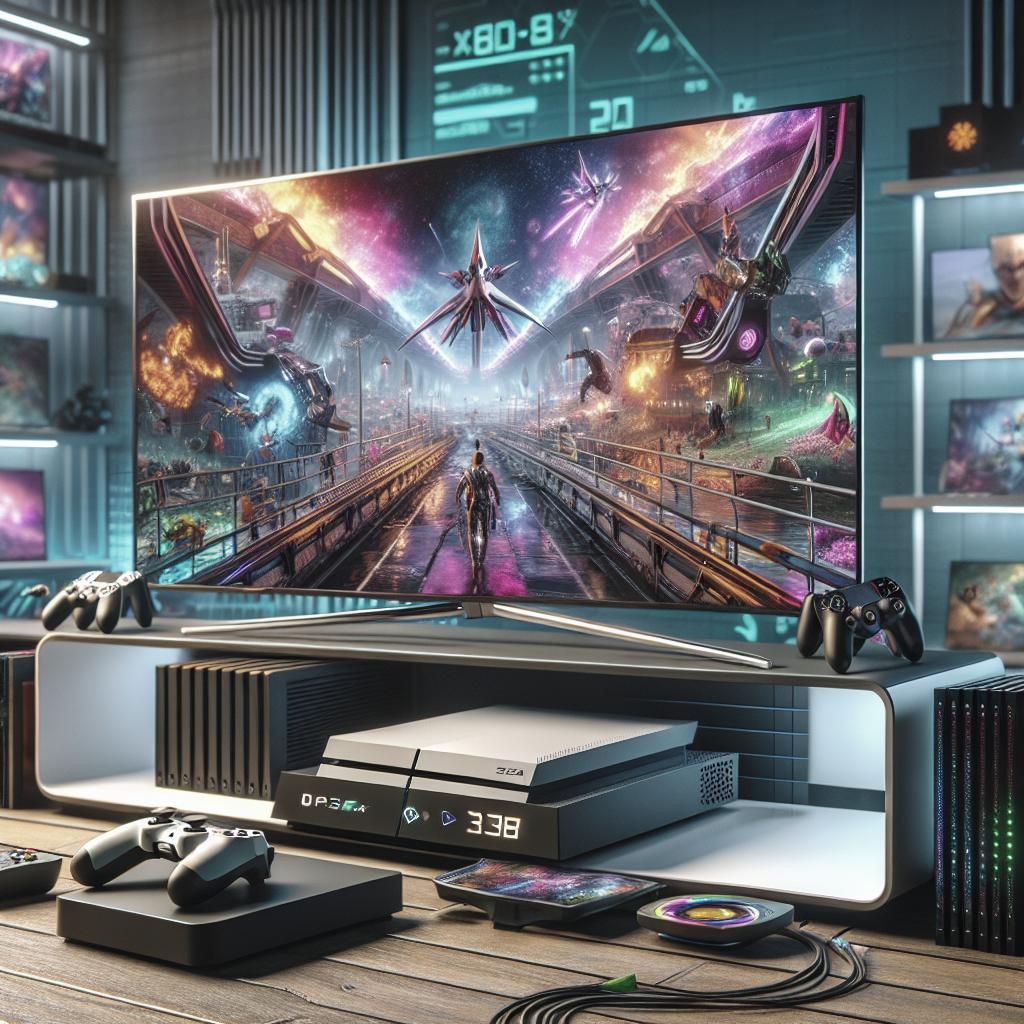Lessons Learned: Enhancing Console Gaming through Graphic Settings In the vibrant world of console gaming, visual fidelity and smooth gameplay reign supreme. With technological advancements in recent years, gamers now enjoy enhanced graphics, intricate details, and richer gameplay across various settings. This post delves deep into the intricacies of these graphic settings, focusing specifically on elements such as 120Hz modes in games like Destiny 2, 4K pixel resolution, ray tracing, frame rates, and more. We’ll explore the impact of these settings on gameplay experience and discuss the practical setup for optimizing graphic settings on consoles. Whether you’re a seasoned gamer or a newcomer, understanding these elements will help you tailor your gaming setup for the best experience possible. Our guide also includes insights from Robert Anderson, a veteran in the gaming world, and recommendations to further elevate your gaming adventure. — ### The Testing Setup To truly understand the impact of graphic settings on console gaming, it’s essential to have a precise and consistent testing setup. Testing begins with choosing the right console; options like the PlayStation 5 and Xbox Series X often deliver on performance with native support for various advanced graphics settings. A state-of-the-art television or monitor that supports 4K resolution and high refresh rates completes the optimal setup. Equally important are the peripherals and environmental settings. Using a high-performance HDMI cable ensures seamless connection, while configuring the gaming environment, such as room lighting and seating distance from the screen, contributes to an immersive experience. All these elements collectively form the foundation of a successful evaluation of graphic settings on consoles. ### Menu and Pause Screens In-game menu and pause screens might seem trivial, but they offer a wealth of customization for enhancing gameplay. Most consoles come with in-depth settings menus where players can toggle between different graphic modes, adjust brightness and contrast, and enable features like motion blur and HDR (High Dynamic Range). Menu settings also influence how games render textures and manage resource allocation for graphics. For instance, adjusting settings to prioritize textures over shadow details can lead to a significant difference in how environments appear within the game. Understanding these menu intricacies allows players to exploit the full potential of their console’s graphical capabilities. ### Testing Destiny 2’s 120Hz Crucible Mode Destiny 2 is a perfect example of how games can leverage enhanced graphic settings to elevate player experience. The game’s Crucible mode offers a 120Hz refresh rate option specifically for competitive multiplayer settings. This high refresh rate mode ensures smoother animations and reduced input lag, which are crucial for fast-paced gaming. However, switching to 120Hz mode often comes with trade-offs. Players might need to sacrifice certain graphic details like shadow quality or post-processing effects, depending on the console’s capability. Testing this mode highlights how a balance between refresh rates and graphical fidelity can be achieved, offering players an optimal yet visually stunning gaming experience. ### What Is Ray Tracing? Ray tracing is a groundbreaking rendering technology that simulates realistic lighting effects. It models how rays of light interact with objects in a virtual environment, resulting in highly detailed shadows, reflections, and ambient light. When enabled on modern consoles, ray tracing can drastically improve how realistic a game feels to the player. Despite its benefits, ray tracing is computationally expensive. It often requires substantial processing power, which can affect overall performance. Gamers must weigh the improvement in graphics against potential dips in frame rates, especially in performance-critical games like shooters or racing simulators. Thus, it remains an option best utilized when gameplay pacing allows for such enhancements. ### What Is Frame Rate? Frame rate, measured in frames per second (fps), is a crucial factor that influences gaming fluidity. Higher frame rates translate to smoother, more responsive gameplay, an essential aspect in competitive gaming. Most modern consoles support frame rates ranging from 30fps to 120fps, depending on the game and graphic settings. Balancing frame rate with graphical detail is often a juggling act. Players must decide whether a higher frame rate is more beneficial than graphic fidelity, which tends to showcase the visual prowess of a game. Understanding how frame rate impacts gameplay can help players make informed decisions when setting up their graphics. ### What Is 4K Pixel Resolution? 4K pixel resolution denotes a display resolution of approximately 4,000 pixels across the horizontal axis, offering unmatched detail and clarity. With more pixels, games can render extraordinary levels of detail, which enhance immersion and make textures appear lifelike. Consoles like the PlayStation 5 and Xbox Series X natively support 4K resolution, leading to crystal clear visuals. However, achieving 4K resolution often requires the console to work harder, potentially affecting the frame rate and overall performance. Although the visual increase is impressive, gamers must ascertain whether 4K’s enhanced quality outweighs potential trade-offs in other gameplay aspects. As technology progresses, more games are optimized for seamless 4K experiences, allowing players to embrace the resolution without significant sacrifices. ### What Is Graphics Mode? Graphics mode in console settings traditionally prioritizes visual quality over performance. Enabling graphics mode allows gamers to experience enhanced visual fidelity, including richer textures, improved lighting effects, and other visual enhancements like antialiasing. Graphics mode is ideal for single-player campaigns or visually driven games where aesthetic appeal holds more weight than reaction time or gameplay fluidity. For those who wish to immerse themselves in cinematic worlds, graphics mode is often the preferred choice, offering an unparalleled visual experience while exploring detailed virtual environments. ### What Is Performance Mode? Conversely, performance mode emphasizes smoother gameplay, often at the cost of reduced visual fidelity. This setting targets higher frame rates by reducing graphical complexity, such as lowering texture resolution or simplifying lighting effects, ensuring that the game runs fluidly without stutters. Performance mode is particularly beneficial in competitive games, where every second counts. Gamers who prioritize responsiveness over visual embellishments will find performance mode advantageous in scenarios requiring split-second decision-making, thereby providing an edge over opponents with its smooth, lightning-fast transitions. ### Game Mode vs. Performance Mode: Which Is Best? Choosing between game mode and performance mode is essentially dependent on the player’s preferences and the type of game being played. Game mode suits titles that emphasize storytelling and intricate settings, creating almost cinematic experiences. Performance mode, meanwhile, suits genres that prioritize action and speed, like fighting games, shooters, or real-time strategy games. Balancing between the two modes can sometimes provide a unique gameplay experience, blending aesthetics with performance. This can be particularly effective in diverse games that encompass both narrative-driven and action-packed segments. Understanding the nuances of each mode empowers gamers to customize their settings per their individual or situational needs. ### Recommended by Our Editors Our editorial team recommends experimenting with these settings to find your personal sweet spot. Testing different modes and noting the variations in gameplay can be beneficial. Consider games you frequently play and tailor settings accordingly—some players create specific profiles for each game type to easily switch and enhance their experience based on the gameplay at hand. Additionally, staying abreast of console updates and game patches is crucial, as developers continually optimize settings, improve performance, and introduce new graphical features. Being proactive about updates ensures your settings leverage the latest technology enhancements available. ### Get Our Best Stories! Our readers can subscribe to our newsletter for insightful stories on gaming technology, the latest in console developments, and tips to optimize settings. Stay connected with a community of passionate gamers and tech enthusiasts by signing up today. Don’t miss out on exclusive content, reviews, and guides directly emailed to your inbox. ### About Robert Anderson Robert Anderson is a veteran gaming journalist whose insights into game technologies and console advancements have shaped industry narratives. With over a decade of experience, Robert has seen firsthand the evolution of gaming graphics and shares his expertise to help others understand complex gaming elements. — “`html
| Section | Focus |
|---|---|
| The Testing Setup | Details on the optimal console setup for testing graphic settings |
| Menu and Pause Screens | How menu settings influence game visuals and performance |
| Testing Destiny 2’s 120Hz Crucible Mode | Exploration of high refresh rate benefits and potential trade-offs |
| What Is Ray Tracing? | Explanation of ray tracing and its impact on game graphics |
| What Is Frame Rate? | The importance of frame rate in gaming fluidity and experience |
| What Is 4K Pixel Resolution? | The benefits and considerations of 4K resolutions in gaming |
| What Is Graphics Mode? | Advantages of prioritizing visual quality via graphics mode |
| What Is Performance Mode? | How performance mode enhances gameplay responsiveness |
| Game Mode vs. Performance Mode: Which Is Best? | Comparison of game and performance modes for varying needs |
| Recommended by Our Editors | Editorial advice on experimenting with settings and staying updated |
| Get Our Best Stories! | Invitation to subscribe for exclusive content and updates |
| About Robert Anderson | Introduction to Robert Anderson and his contributions to gaming journalism |
“`


